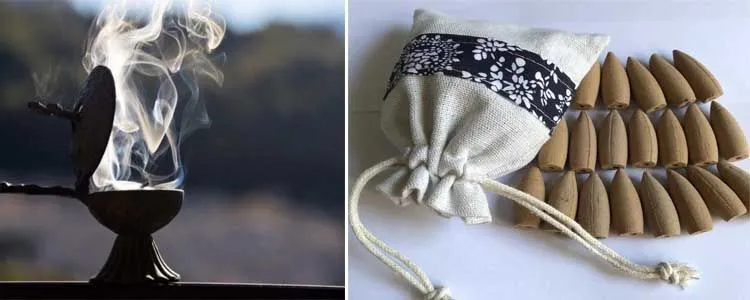Incense is a useful compound that burns to emit a pleasant fragrance into the environment. In fact, the origin of the word “incense” comes from the Latin term meaning “to burn.”
This element has been around for many years. In ancient times, it was used in religious rituals in places such as Egypt, Greece, and Babylon. Over the centuries, incense has continued to be used in various ways.
- It is still used for prayer and religious practices.
- It helps to reduce unpleasant odors in the environment.
- It is also included as an ingredient in aromatherapy.
Table of Contents
What Is Incense Composed Of?
Incense is usually composed of aromatic materials that are capable of emitting a fragrance, in addition to a combustible element that keeps it burning until it is completely consumed.
The ingredients and aromas used for its manufacture are typically of vegetable origin and include a wide variety of barks, resins, roots, seeds, and even flowers.
The most commonly used ingredients, depending on the manufacturer and the region where it is produced, are usually the following:
In general, the materials used for the combustion of the stick are typically wood or charcoal, elements as natural as possible since they will be emitted into the air that we breathe when burned.
How to Burn Incense

To this day, we have several options for purchasing incense, and it’s not always the well-known wooden stick.
On the market, we find various forms of incense, including:
- Coils
- Cone shapes
- Powders to add to the fire
- Sticks (the most common)
- Pack of 7 Boxes (15 gm each) Satya Nag Champa, Super hit, Dragon’s Blood, Sandalwood, Patchouli, Lavender & Positve Vibes Incense Sticks.
To start burning incense, the first step is to light it gently. Once lit, a small flame will appear, which should be extinguished with a gentle blow.
After this, the incense will glow and begin to produce scented smoke. Even if there is no visible flame or orange glow from the combustion, it doesn’t mean it’s not burning. The aroma and smoke will indicate its presence.
The time it takes for incense to be fully consumed varies depending on its shape and length. A typical incense stick lasts between 50 minutes and 1.5 hours.
Keep in mind that burning incense can pose a fire hazard. Even if there is no visible flame, a gust of air or vibrations might cause the stick or coil to fall and potentially ignite nearby curtains, paper, or cardboard.
General recommendations for those who use incense in aromatherapy are as follows:
- Use an appropriate burner.
- Place the burner on a fire-resistant surface that can withstand high temperatures.
- Avoid leaving burning incense unattended.
The last recommendation is particularly important and reflects common sense.
Does Incense Provide Benefits for Our Health?
At this point in the article, we will examine the main scientific reviews concerning the use of incense in aromatherapy.
Some of the ingredients used in incense, such as cinnamon, myrrh, and the plant Plectranthus madagascariensis, are known for their health benefits. However, the effects of these medicinal plants when used as infusions or applied topically are different from their effects when used as aromatic gases.
Research on the health benefits of burning incense is limited. Many existing studies focus primarily on the ingredients of frankincense or myrrh, rather than the incense smoke itself.
Although incense burning is often associated with religious practice and meditation, it does not necessarily offer benefits for conditions such as anxiety, depression, or respiratory diseases.
What Does Science Say About This?
A scientific study conducted in 2008 on animals identified a substance in the resin that could potentially activate responses similar to those produced by antidepressant drugs. The study analyzed brain behavior and found that areas associated with anxiety, stress, and depression were activated. [See study]
Additionally, another study found that resins from plants like frankincense and myrrh had anti-inflammatory effects, again evaluated in animals.
However, these studies focused on the resins themselves, not the smoke produced by burning them.
Therefore, there are no conclusive reports that incense smoke has direct health benefits. Its potential benefits might be more indirectly related to stress relief through meditation practices.

Can Smoke Be Harmful to Your Health?
Similar to tobacco smoke, hookah smoke, or even electronic cigarette vapor, the potential health repercussions of inhaling smoke from various extracts, not necessarily all from plants, must be considered.
Smoke consists of a variety of components, including tiny particles generated from burning compounds, which produce vapors such as carbon monoxide.
Scientific information confirms that inhaling large amounts of these gases can have harmful effects.
Long-term exposure to incense smoke has been associated with an increased risk of squamous cell lung cancer. [Scientific essay]
However, there is no conclusive evidence linking incense smoke production to a higher prevalence of asthma or respiratory diseases. [Source of information]
A recent study conducted in China found evidence suggesting that burning incense could be associated with increased hypertension in adults. [See study]
Conclusions
There is no scientific evidence supporting physical health benefits of incense, at least in animal studies. However, it may help reduce stress, anxiety, and facilitate meditation for many people, which can contribute to mental well-being.
On the other hand, habitual and long-term exposure to incense smoke, due to the volatile compounds it produces, can be harmful and may lead to serious health issues.
The use of incense is not common for most people, who typically use it for a maximum of 1 hour and avoid prolonged exposure to the smoke.


